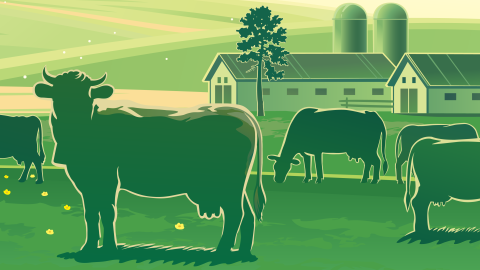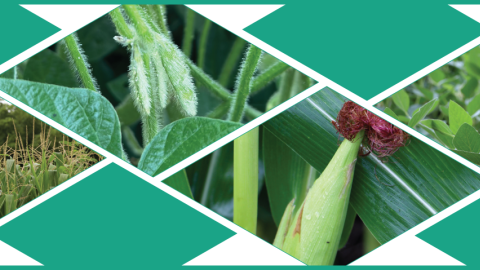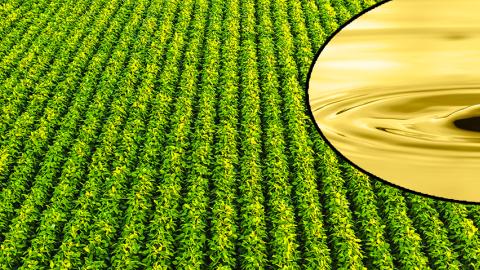Effective beginning 6/2/2025:
This website, and all linked websites under the control of the agency, is under review and content may change.
ERS conducts research on a range of climate change issues related to agriculture, including:
- The impacts of climate change and weather on crop production, livestock production, and international trade
- The implications of climate change for agricultural markets and the cost of government policies/programs
- The potential for agriculture to adapt to changing climate conditions
- The potential within agriculture for mitigation of greenhouse gas emissions
- The role of USDA farm programs under changing climate conditions
- Drought resilience and risk management
See the sidebar links to ERS climate-related resources; selected publications are highlighted below.
The Fifth U.S. National Climate Assessment (NCA5) surveyed recent scientific literature on climate change, impacts, adaptation, and mitigation. Quoting NCA5, these are major findings:
- Global average temperatures over the past decade (2012–2021) were close to 2°F (1.1°C) warmer than the preindustrial period (1850–1899) (NCA5, Ch. 2, page 2-10).
- Global surface temperatures will continue to rise until CO2 emissions reach net zero, and surface temperatures are not expected to fall for centuries in the absence of net-negative emissions (NCA5, Ch. 2, page 2-29).
- Temperatures in the contiguous United States have risen by 2.5°F and temperatures in Alaska by 4.2°F since 1970, compared to a global temperature rise of around 1.7°F over the same period. This reflects a broader global pattern in which land is warming faster than the ocean, higher latitudes are warming faster than lower latitudes, and the Arctic is warming fastest of all (NCA5, Ch. 2, page 2-11).
- Many eastern regions of the country are getting wetter. Average annual precipitation from 2002–2021 was 5% to 15% higher relative to the 1901–1960 average in the central and eastern United States, a trend attributable to climate change (NCA5, Ch. 2, page 2-11).
- Strong reductions in emissions of both CO2 and non-CO2 greenhouse gases (e.g., methane and nitrous oxide) are required to limit human-induced global warming to specific levels (NCA5, Ch. 2, page 2-5).
Agricultural Greenhouse Gas Emissions
The U.S. Environmental Protection Agency (EPA) publishes annual estimates of U.S. greenhouse gas emissions, including emissions from agriculture (see Inventory of U.S. Greenhouse Gas Emissions and Sinks: 1990–2022, April 2024). USDA publishes a supplemental greenhouse gas inventory for agriculture less frequently, but it provides further background and regional detail not available in the EPA inventory (see the most recent USDA report, U.S. Agriculture and Forestry Greenhouse Gas Inventory: 1990–2018, USDA, Office of the Chief Economist, Technical Bulletin No. 1957, January 2022).
The greenhouse gases with the largest contribution to rising temperature are carbon dioxide (CO2), methane (CH4), and nitrous oxide (N2O). In estimating total emissions, global warming potentials (GWPs) are used to calculate carbon-dioxide equivalents for methane and nitrous oxide to sum emissions impacts over different gases.
EPA estimates that agriculture accounted for 10.5 percent of U.S. greenhouse gas emissions in 2022. Of the 10.5 percent, electricity-related CO2 emissions accounted for 0.5 percent, and CO2 from on-farm energy use accounted for 0.8 percent. Agricultural practices that emit nitrous oxide include nitrogen fertilizer application and manure management. Major sources of agricultural methane emissions include enteric fermentation, manure management, and rice cultivation.
Globally, carbon dioxide emissions are the largest contributor to climate change. However, the emissions profile for agriculture differs from that of the overall economy. U.S. agriculture emitted an estimated 663.6 million metric tons of carbon-dioxide equivalent in 2022: 46.6 percent as nitrous oxide, 41.7 percent as methane, and 11.6 percent as carbon dioxide (EPA 2024).
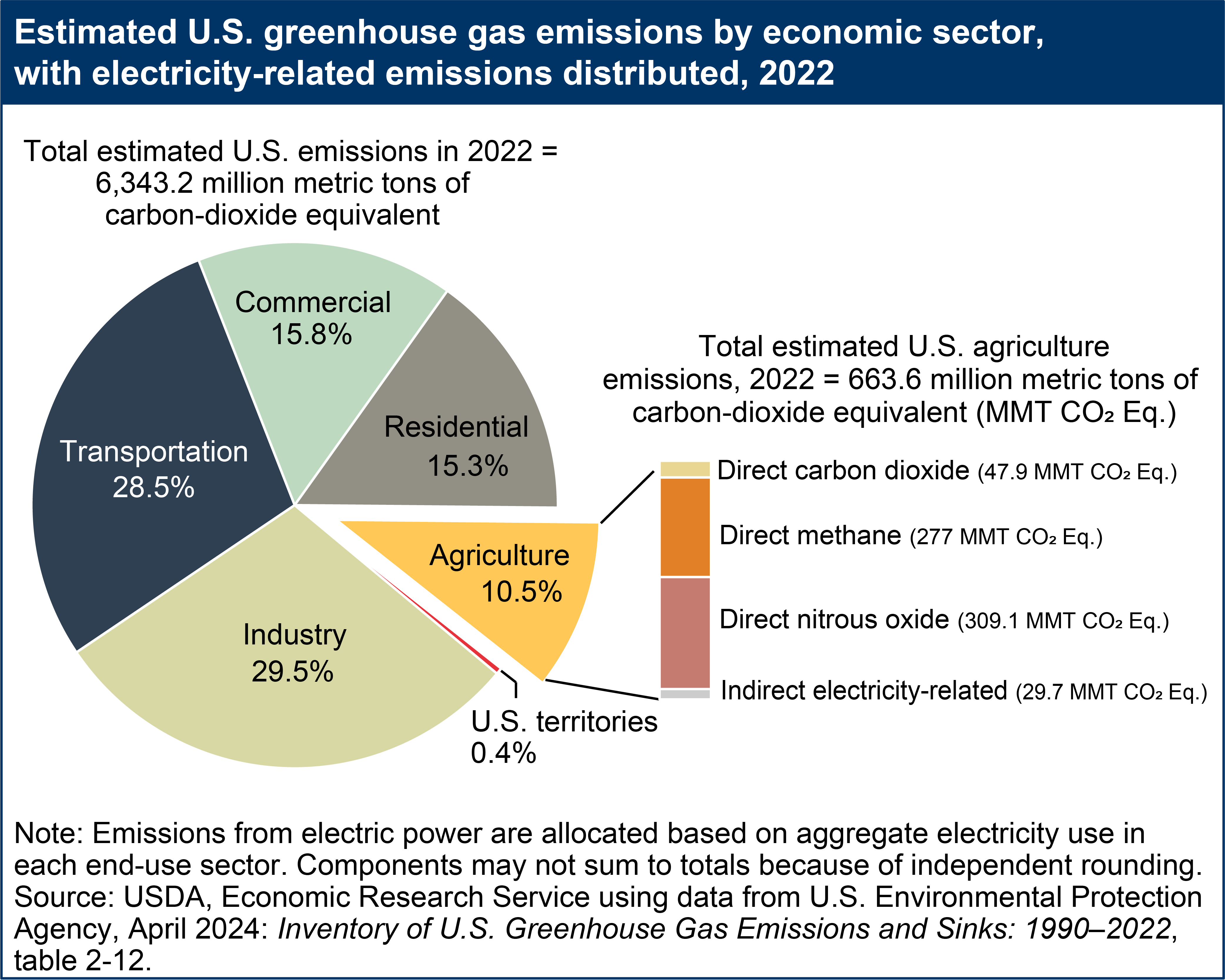
Download chart image | Chart data
The EPA Inventory of U.S. Greenhouse Gas Emissions and Sinks: 1990–2022 (EPA 2024) also includes a land use, land-use change, and forestry (LULUCF) chapter, which provides an estimate of emissions (sources) and removals (sinks) from LULUCF conversions between forest land, cropland, grassland, wetlands, and human settlements. Carbon sinks include forest management to increase carbon in forests, harvested wood products, increases in tree carbon stocks in settlements, conversion of agricultural to forest land (afforestation), and crop management practices that increase carbon in agricultural soils (EPA 2024). The LULUCF estimated net sink is 854.2 million metric tons of carbon-dioxide equivalent in 2022.
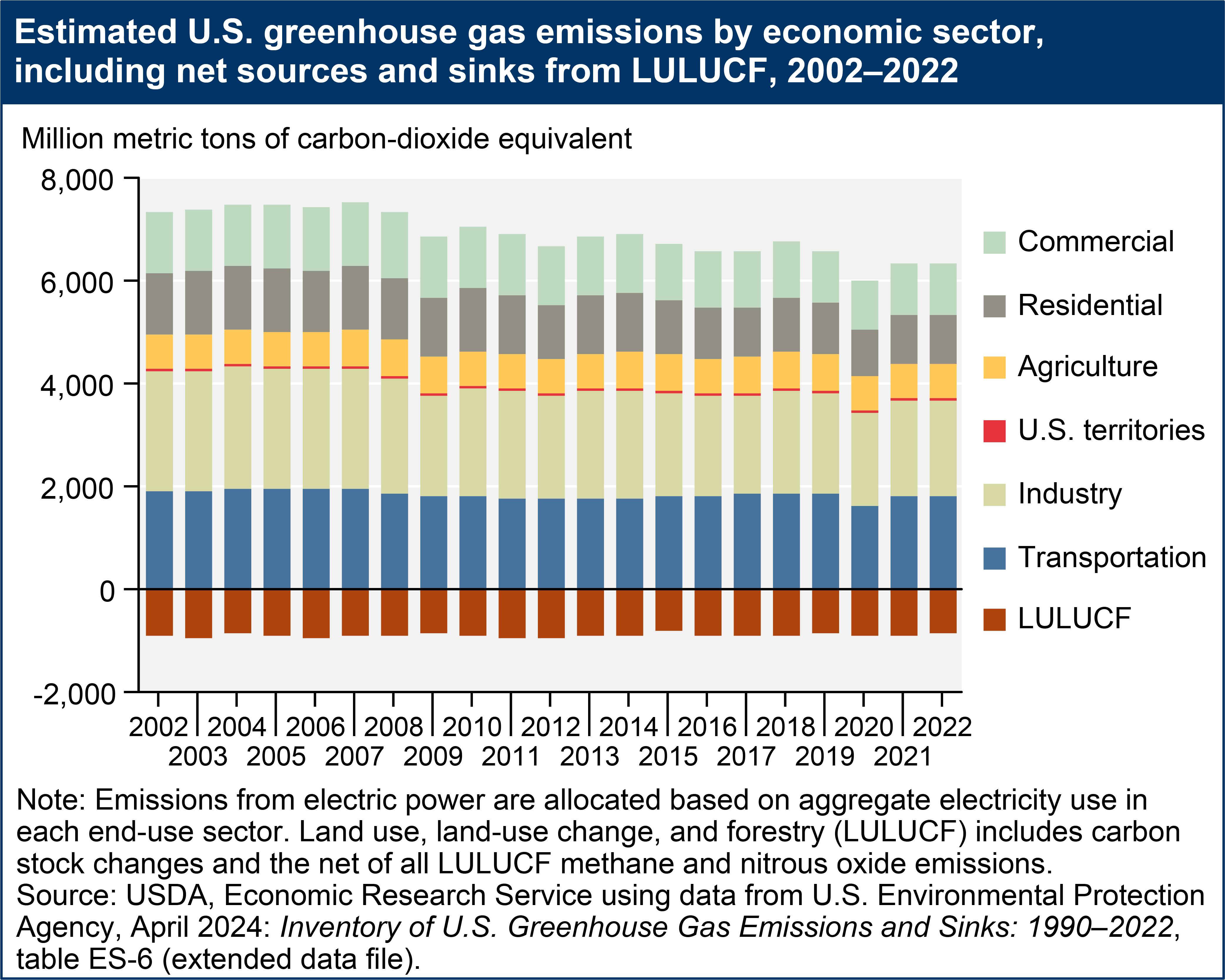
Download chart image | Chart data
Climate Change Impacts and Agricultural Adaptation
All dimensions of food security—availability, accessibility, utilization (or usability), and stability—are expected to be affected by climate change through long-term changes in average climatic conditions (e.g., annual precipitation and temperature), as well as increases in climate variability and the frequency, magnitude, and duration of climate extremes (NCA5, Ch. 11, page 11-14). These impacts will affect national and international markets; the prices of food, fiber, and energy; agricultural incomes; and the environment. How farmers respond or adapt—possibly mediated by policy and technology changes—will ultimately determine the impact of these altered growing conditions on production, natural resources, and food security. ERS publications that consider climate change and agricultural adaptation include:
- Climate-Induced Yield Changes and TFP: How Much R&D Is Necessary To Maintain the Food Supply? (ERR-333, July 2024) To assess the potential impact of climate change on food supply and demand, yield change estimates were determined for corn, rice, soybeans, and wheat. These estimates were based on climate projections from global climate models and global gridded crop models. If no additional R&D expenditures are made (beyond 2016 expenditures), then total-factor-productivity (TFP) growth would be insufficient to meet global demand for the four crops in 2050.
- Climate Change and Agricultural Risk Management Into the 21st Century (ERR-266, July 2019). The Federal Government offers subsidized premiums on crop insurance as one method of helping farmers manage risk. The Federal Government’s cost exposure under this program is expected to increase as weather averages and extremes change over the coming decades. Cost estimates would be higher if the analysis did not account for adaptation to climate change. See also the related Amber Waves finding, Climate Change Projected To Increase Cost of the Federal Crop Insurance Program due to Greater Insured Value and Yield Variability (November, 2019).
- Development, Adoption, and Management of Drought-Tolerant Corn in the United States (EIB-204, January 2019). Introduced in 2011, drought-tolerant corn accounted for 22 percent of total U.S. corn-planted acreage in 2016. Using data from USDA's Agricultural Resource Management Survey, this report documents trends in its development, adoption, and management, examining the role of drought exposure and moisture conservation practices, as well as genetically engineered seed traits, pricing, and irrigation.
- Climate Change, Water Scarcity, and Adaptation in the U.S. Fieldcrop Sector (ERR-201, November 2015). Climate change is projected to adversely impact yields of corn, soybeans, rice, sorghum, cotton, oats, and silage, with some impacts as early as 2020. The potential reallocation of acreage into irrigated production in response to climate change may be constrained by limits on the regional availability of water resources and on declining relative profitability of irrigated production under conditions of heat stress.
- Climate Change, Heat Stress, and U.S. Dairy Production (ERR-175, September 2014). In the United States, climate change is likely to increase average daily temperatures and the frequency of heat waves. Dairy cows are particularly sensitive to heat stress, and the dairy sector has been estimated to bear over half of the costs of current heat stress to the livestock industry.
Agricultural Production and Climate Change Mitigation
There are many opportunities to decrease greenhouse gas emissions of croplands and pasture, including improving soil health, improving nitrogen fertilizer management, increasing the number of trees and other perennials on the landscape, and reducing methane emissions (NCA5, Ch. 32, page 32-20). Farm operators can change production practices or land use to increase the carbon stored in soil or vegetation. Other changes in production practices and land use can result in reduced emissions of methane and nitrous oxide. In addition, agriculture can produce biofuels, which can substitute for fossil fuels and reduce greenhouse gas emissions across multiple sectors. These actions are considered forms of climate change mitigation. ERS publications that consider climate change mitigation include:
- Trends, Insights, and Future Prospects for Production in Controlled Environment Agriculture and Agrivoltaics Systems (EIB-264, January 2024) Controlled environment agriculture consists of crop production systems in greenhouses or other structures that use horticultural and engineering techniques beyond conventional soil-based outdoor production. Agrivoltaics are the colocation of solar panels and agricultural production. As of 2021, most of the approximately 300 agrivoltaic sites were solar farms planted with pollinator-friendly vegetative cover. See also the related Amber Waves finding Common Ground for Agriculture and Solar Energy: Federal Funding Supports Research and Development in Agrivoltaics (April, 2024).
- Cover Crop Trends, Programs, and Practices in the United States (EIB-222, February 2021). Depending upon the field, soil, climate, and weather, cover crops can result in a variety of on farm benefits: reduced soil erosion and compaction, improved water infiltration and storage within the soil profile, greater weed and pest suppression, and better nutrient cycling and soil stability to support machine operations. Cover crops can also provide public environmental benefits: less runoff of sediments and nutrients into waterways, reduced flooding in watersheds, and greater soil carbon sequestration.
- Resource Requirements of Food Demand in the United States (ERR-273, May 2020). Three main factors determine the resource requirements of food demand: population, diet, and technology. This study focused on the use of natural resources in the U.S. food system by examining one of these factors, diet, to illustrate how food choices can affect use of resources.
- Tillage Intensity and Conservation Cropping in the United States (EIB-197, September 2018). Most U.S. farmers prepare their soil for seeding, weed and pest control through tillage-plowing operations that disturb the soil. Tillage practices affect soil health, soil carbon content, water pollution, and farmers' energy and pesticide use, and therefore data on tillage can be valuable for understanding the practice's role in reaching climate and other environmental goals.
- Dedicated Energy Crops and Competition for Agricultural Land (ERR-223, January 2017). Crops that are grown strictly for energy use, such as switchgrass in the United States, have received much attention as potential renewable sources for bioelectricity; however, markets do not presently exist for large-scale use of this resource. This study examines three policy scenarios that could create a market for bioelectricity using dedicated energy crops.

